Recent research has unveiled the critical role that ocean dynamics—specifically, the churning of the upper layers of the Atlantic Ocean—play in influencing long-term climate patterns worldwide. This study sheds light on a previously underemphasized factor: the mixed layer of the ocean. Researchers have identified this upper layer, where interactions between wind and waves combine warm surface and cooler deeper waters, as a significant driver behind a climate phenomenon known as Atlantic Multidecadal Variability (AMV). This discovery alters the traditional perception that atmospheric heat exchange was the primary mechanism at work, suggesting instead that oceanic conditions are vital to understanding climate variability.
The AMV is a complex phenomenon influencing weather not just in the tropics but also across continents, extending its effects to regions like North America, Europe, and Africa. For instance, variations in the AMV have been shown to impact hurricane activity in the Caribbean and alter rainfall patterns in the Sahel. According to Dr. Balaji Senapati, the lead researcher from the University of Reading, their findings prompt a reevaluation of the interplay between the ocean and atmosphere. The idea that the depth of the mixed layer governs climate variability adds a layer of complexity to existing models and emphasizes the ocean’s influence over atmospheric conditions.
The latest study reveals a feedback mechanism that operates based on ocean temperatures across the North Atlantic region. When this area is warmer than average, trade winds weaken. This change leads to a shallower mixed layer of the ocean, which is particularly noticeable during the summer months. The thinner layer allows sunlight to penetrate more efficiently, resulting in intensified warming of the tropical Atlantic. This phenomenon establishes a self-reinforcing cycle: higher temperatures reduce trade wind strength, further shallow the mixed layer, and perpetuate warming.
Conversely, in cooler phases of the AMV, this cycle reverses, contributing to lower temperatures in the Atlantic. This cyclical nature is crucial for climate modeling and long-term forecasting, as it highlights a dynamic interplay that many models might overlook.
The implications of this research extend far beyond academic interest; they hold significant promise for advancing climate forecasting capabilities. Current climate models may inadequately represent the complex processes occurring within the ocean’s upper layers, leading to potential inaccuracies in predicting AMV patterns and their global impacts. Integrating a deeper understanding of oceanic mixing processes into these models could enhance predictive accuracy, ultimately helping policymakers better prepare for the ramifications of climate variability.
As the scientific community continues to unravel the complexities of ocean-atmosphere interactions, the insights gained from this study will be instrumental in crafting effective responses to the challenges posed by climate change. The ocean, as evidenced by this research, is not merely a backdrop for atmospheric phenomena; rather, it serves as a powerful engine driving some of the most critical aspects of our planet’s climate dynamics.

